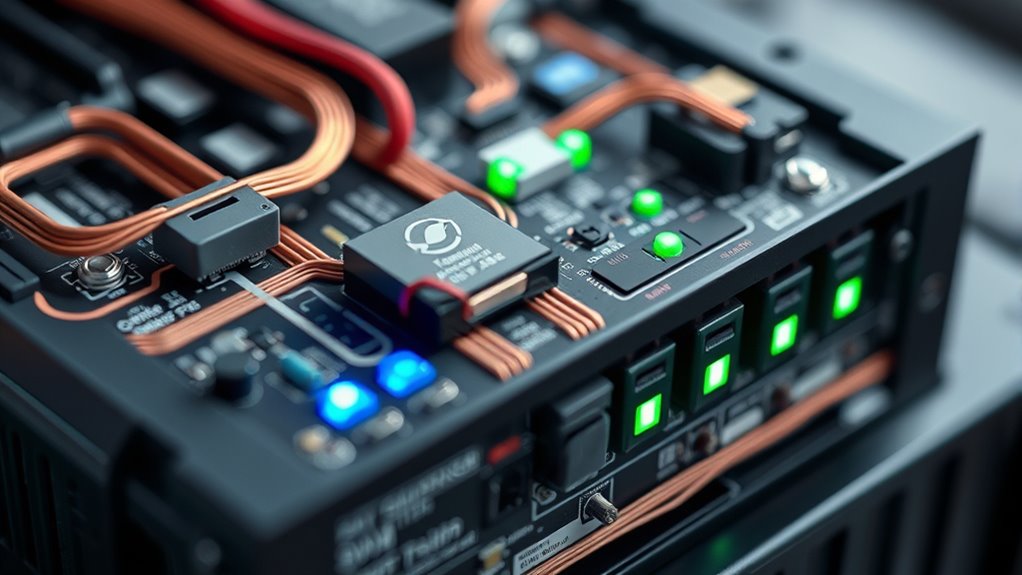A Battery Management System (BMS) plays a crucial role in keeping your battery safe and reliable. It manages charging and discharging, prevents overcharging, deep discharge, and detects faults like overheating or short circuits. It also balances individual cells and maintains ideal temperature for longevity and safety. By actively monitoring performance, the BMS ensures your device runs efficiently and safely. Continue to explore how these systems safeguard and extend your battery’s life in various applications.
Key Takeaways
- BMS prevents overcharging, deep discharging, and manages faults to ensure battery safety and longevity.
- It estimates the State of Charge (SoC) to provide accurate charge levels and optimize energy use.
- BMS balances individual cells and regulates temperature to maintain uniform performance and prevent overheating.
- It monitors critical parameters like voltage, current, and temperature for early fault detection and safety.
- BMS maximizes battery lifespan and reliability, essential for applications like electric vehicles, smartphones, and energy storage systems.

Another important aspect is the choice of projector technology, such as DLP or LCD, which significantly affects color fidelity and image quality. When you use a device powered by a rechargeable battery, you want to know precisely how much charge remains before needing a recharge. The BMS constantly assesses the battery’s state of charge (SoC) by analyzing voltage, current flow, and temperature data. This real-time information helps prevent overcharging or deep discharging, both of which can harm the battery and shorten its lifespan. Precise SoC estimation also improves user experience by providing reliable charge indicators, so you don’t get caught off guard with a sudden power loss. It allows for smarter energy management, guaranteeing the battery’s capacity is used efficiently and safely.
Beyond thermal regulation and state of charge estimation, a BMS performs other critical functions, such as balancing individual cells, detecting faults, and managing charging and discharging cycles. Cell balancing is essential because it ensures all individual cells within a battery pack share similar voltage levels. Without it, some cells might degrade faster, leading to reduced capacity and potential safety hazards. Fault detection is equally important, as it identifies issues like short circuits, overheating, or deteriorating cells early enough to prevent catastrophic failures. The BMS also controls charging rates, making sure the process is safe and optimal, which helps maximize the battery’s lifespan.
In essence, without a well-designed BMS, modern batteries would be far less reliable and safe. It acts as the brain and protector of the system, continuously working behind the scenes to optimize performance, safety, and durability. Whether in electric vehicles, smartphones, or renewable energy storage, the BMS is fundamental to unlocking batteries’ full potential. By maintaining proper thermal regulation and providing accurate state of charge estimation, it ensures that your batteries serve you well over time, delivering power when you need it most.
Frequently Asked Questions
How Does a BMS Improve Battery Lifespan?
A BMS improves your battery lifespan by monitoring and managing its health. It performs battery calibration to guarantee accurate readings, preventing overcharging or deep discharging. Voltage balancing distributes energy evenly across cells, reducing stress and wear. By maintaining ideal operating conditions, the BMS minimizes damage and degradation, helping your battery last longer and perform reliably over time.
What Are the Key Components of a BMS?
Ever wondered what keeps your battery safe and efficient? The key components of a BMS include sensors for cell voltage and temperature, a controller for data processing, and safety devices for fault detection. Cell balancing ensures uniform charge across cells, preventing damage. You rely on fault detection to catch issues early, protecting your battery’s longevity. These components work together to optimize performance and guarantee your battery operates smoothly and safely.
Can BMS Be Integrated Into Existing Battery Systems?
Yes, you can integrate a BMS into existing battery systems. Focus on battery integration and system compatibility to guarantee seamless operation. You’ll need to assess your current setup, verify voltage and capacity matches, and choose a BMS compatible with your batteries. Proper integration enhances safety, performance, and longevity, making it a worthwhile upgrade. Consult with experts or manufacturers to optimize compatibility and avoid potential issues during installation.
How Does BMS Handle Thermal Management?
Ever wonder how a BMS keeps your battery from turning into a fiery mess? It uses thermal regulation, actively managing heat to prevent overheating. Temperature sensors constantly monitor the battery’s heat levels, feeding data back to the system. When temps rise too high, the BMS kicks in, adjusting cooling or limiting charge to keep everything safe and cool. Because nobody wants a battery that’s more hot mess than energy source.
What Are Common Challenges in BMS Development?
You face challenges in BMS development like managing software complexity and guaranteeing calibration accuracy. As you develop the system, you need to simplify software to prevent errors and improve reliability. Additionally, precise calibration is vital for accurate battery monitoring, but it can be difficult to achieve consistently. Balancing these factors requires careful design, thorough testing, and continuous refinement to assure optimal performance and safety of the battery system.
Conclusion
So, next time your battery seems to last forever, thank the unsung hero behind the scenes—your Battery Management System. It quietly keeps everything in check, preventing disasters you’d rather not imagine. Ironically, it’s the tiny guardian working tirelessly, often unnoticed, ensuring your device’s life isn’t cut short by just a little mismanagement. Without it, your gadgets might just turn into expensive paperweights—proof that sometimes, the smallest things keep the biggest problems at bay.










